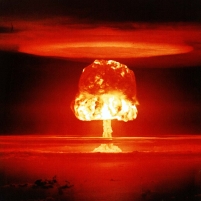20 Government Tips for Surviving a Nuclear Attack
Monday, January 03, 2011

The Obama administration is working on new guidelines for the public to follow in the event of a nuclear explosion, whether it comes from a missile attack or a terrorist “dirty bomb.” The biggest challenge for government officials is figuring out how to educate Americans about surviving such a traumatic event without alarming people, especially since the main message they’ve crafted is: “Don’t panic, don’t flee the city, and find the nearest shelter available.”
An interagency working group has developed recommendations designed to help people survive the fallout from a nuclear explosion.
If you are too near the spot where a bomb is detonated, you will not survive. But by acting quickly, it is possible for many people to avoid the lethal effects of radiation that follow an explosion. Here are a few tips:
1. Find the nearest and strongest building you can and go inside to avoid radioactive dust outside.
2. If better shelter, such as a multi-story building or basement can be reached within a few minutes, go there immediately.
3. If you are in a car, find a building for shelter immediately. Cars do not provide adequate protection from radioactive material.
4. Go to the basement or the center of the middle floor of a multi-story building (for example the center floors (e.g., 3 – 8) of a 10-story building).
5. Put building walls, brick, concrete or soil between you and the radioactive material outside.
6. Increasing the distance between you and the exterior walls, roofs, and ground, where radioactive material is settling.
7. Stay inside. Do not come out until you are instructed to do so by authorities or emergency responders.
8. Stay tuned to television and radio broadcasts for important updates.
9. Radiation levels are extremely dangerous after a nuclear detonation, but the levels reduce rapidly in just hours to a few days. During the time when radiation levels are the highest, it is safest to stay inside, sheltered away from the material outside.
If you have been exposed to radiation, here are more tips:
1. Remove your clothing to keep radioactive dust from spreading.
2. You should act as if you are going home covered in mud and you do not want to track mud into your home.
3. Place your clothing in a plastic bag and seal or tie the bag. This will prevent the radioactive material from spreading.
4. Place the bag as far away as possible from humans and animals to limit exposure.
5. Removing the outer layer of clothing can remove up to 90% of the radioactive dust.
6. When possible, take a shower with lots of soap and water to limit radiation contamination. Do not scrub the skin.
7. Wash your hair with shampoo or soap and water.
8. Do not use conditioner on your hair because it will bind radioactive material to your hair, keeping it from rinsing out easily.
9. Gently blow your nose and wipe your eyelids and eyelashes with a clean wet cloth. Gently wipe your ears.
10. If you cannot shower, use a wipe or clean wet cloth to wipe your skin that was not covered by clothing.
11. Put on clean clothing, if available.
-David Wallechinsky, Noel Brinkerhoff
U.S. Rethinks Strategy for the Unthinkable (by William Broad, New York Times)
Planning Guidance for Response to a Nuclear Detonation (National Security Staff Interagency Policy Coordination Subcommittee for Preparedness and Response to Radiological and Nuclear Threats) (pdf)
- Top Stories
- Unusual News
- Where is the Money Going?
- Controversies
- U.S. and the World
- Appointments and Resignations
- Latest News
- Trump to Stop Deportations If…
- Trump Denounces World Series
- What If China Invaded the United States?
- Donald Trump Has a Mental Health Problem and It Has a Name
- Trump Goes on Renaming Frenzy






Comments